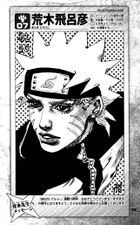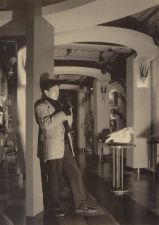Hirohiko Araki
Hirohiko Araki (荒木 飛呂彦, Araki Hirohiko) is a mangaka and author of JoJo's Bizarre Adventure, on which this wikia project is based.
Biography
Hirohiko Araki was born on June 7 1960 in Sendai, Japan. Araki left school before graduation from Miyagi University of Education.
Araki is best known for JoJo's Bizarre Adventure, published in Weekly Shonen Jump from 1987 to 2002, before the series transferred to the seinen magazine Ultra Jump in 2004.
Araki's Buso Poker was a "Selected Work" at the Tezuka Award in 1980.[1]
In 2012, Araki celebrates his 30th year as a manga artist and the 25th anniversary of JoJo’s Bizarre Adventure.
JoJo's Bizarre Adventure
The course of the story in JoJo takes the protagonists and the reader through numerous countries and the experience of many cultures. Through various means and at various degrees of factual accuracy and fictionalisation, the history and cultures of Britain, the U.S., the Middle East, Japan and Italy, in particular, are explored and annotated.
Various names, styles, symbols, concepts and segments of plot originating with extant music, film, literature, fashion, television, comics/manga and modern art can be read throughout the story. The characterization of allies and enemies in JoJo frequently arrive as the synthesis of a selection of these elements. Similarly, selections of scientific theory and occultism, mythology and fantasy inform the functions of JoJo's multitude of unique Stand powers.
The series spans a range of genres including Science fiction, Paranormal and the supernatural, Mystery, Thriller, Action and Adventure. Recurrent themes include social Class; Ethics and morality; Crime and Punishment; Health, Psychology and Memory; Fortune, Religion and Redemption; physical principles such as Gravity, Time and Energy; and Evolution, Family, and Lineage.
The character Rohan Kishibe may be considered a vehicle for the most self-conscious events and topics in the story, whilst the situations described in the fictional town of Morioh, the base of Part IV: Diamond is Unbreakable and the ongoing Part VIII: Jojolion, may represent the most up-to-date aspects of Araki's personal interests or most personally relevant events and trends in contemporary culture (notably the 2011 Tohoku earthquake).
JoJo maintains a number of icons, symbols and shapes with vague or unspecified meanings such as a Star, a Heart, an Anchor, a Ladybird, an Arrowtip, the Peace symbol, and the Palm of a hand, as the most recurrent.
Style and Influences
Araki has named Paul Gauguin and his approach and contribution to color theory as a key influence.
A consistent element of Araki's drawing and layout is a highly dynamic treatment of the picture plane. In terms of cartooning, a comparison may be drawn between Parts I, II and III and Tetsuo Hara's physiological ideals as exhibited in Hokuto no Ken (Fist of the North Star), itself described by Hara and writer Buronson as emblematic of 1980s popular culture. Part IV exhibits a transition to a more androgynous description of human characters; Part V amends an element of haute couture; while Part VI explores designer/brand/label or 'trendy' fashion, and through Romance, sexual dimorphism.
Illustrations of the protagonists in Part VII: Steel Ball Run are powerfully reminiscent of the photographic conventions of fashion magazines and certain celebrity personalities of the 2000s. Combination of layout with depth of field, perspective and landscape, probably inspired by the story's namesake The Cannonball Run (dir. Hal Needman, 1981), spaghetti western, racing and cinema itself lends a cinematic presentation.
Publication
Many of Araki's creations including JoJo's Bizarre Adventure have been translated and released in Europe, but so far only JoJo and Baoh have been released in the U.S., one theory being that Araki's frequent references to Western music, film, and others violate U.S. copyright law. Publications by Viz Media replace certain references within the copy of the manga with thematically comparable alternatives. The American localization of Capcom's fighting games based on JoJo follow the same procedure.
Works
- Buso Poker (1980)
- Autoto Man (1982)
- Virginia ni Yohroshiku (1982)
- Magic Boy B.T. (魔少年ビーティー mashōnen bītī 1982–1983)
- Baoh (1984–1985)
- Gorgeous Irene (1985–1986)
- JoJo's Bizarre Adventure (1987—current)
- Part I: Phantom Blood (1987-1988)
- Part II: Battle Tendency (1988-1989)
- Part III: Stardust Crusaders (1989-1992)
- Part IV: Diamond is Unbreakable (1992-1996)
- Part V: Vento Aureo (1996-1999)
- Part VI: Stone Ocean (2000-2003)
- Part VII: Steel Ball Run (2004-2011)
- Part VIII: Jojolion (2011-current)
- JoJo 6251 (1993) (Artbook)
- Under Execution, Under Jailbreak (Collection) (1999)
- JOJO A-GO!GO! (2000) (Artbook)
- The Lives of Eccentrics (2004)
- Thus Spoke Rohan Kishibe - Mutsukabeza (2006)
- Front cover of Cell (scientific journal) (September 7, 2007)
- Rohan at the Louvre (2010)
- Spur Spinoff (2011)





